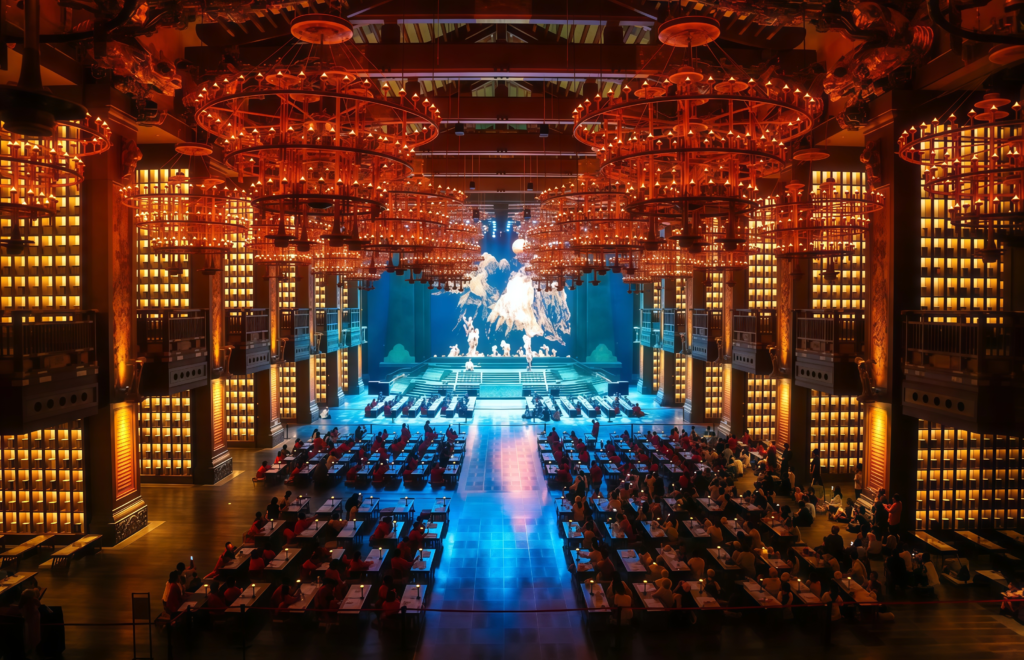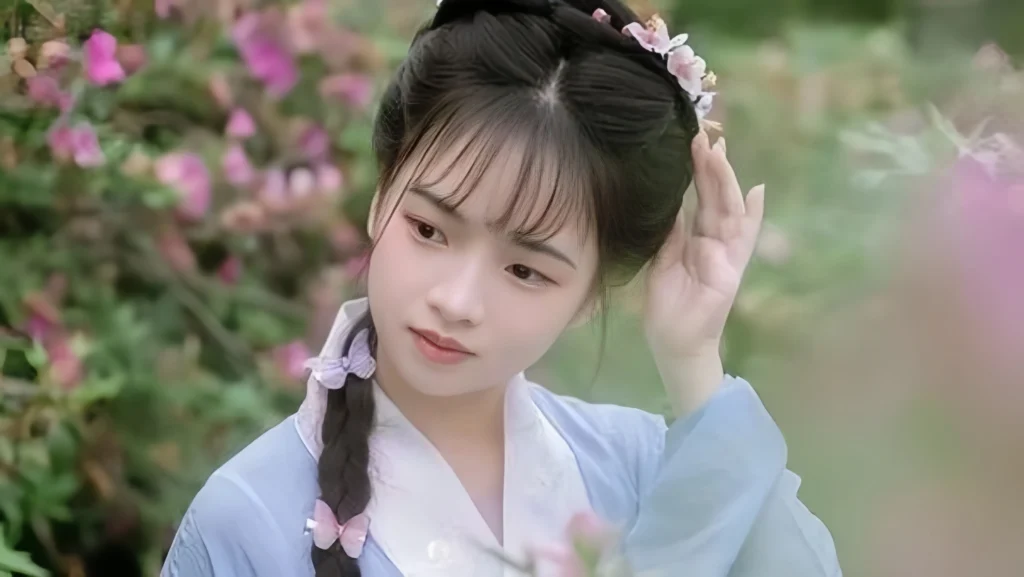Gradient Colors That Tease the Spring Light, Perfect for You to Wear

In the vibrant hues of spring, gradient hanfu emerges as a stunning fusion of ancient Chinese aesthetics and modern fashion. Inspired by the Tang dynasty’s bold embrace of color, these flowing garments capture the essence of nature’s palette, from misty mountain blues to sunrise golds. Whether you’re drawn to the poetic shimmer of a qiyao shanqun or the airy elegance of a shanqun set, gradient hanfu offers a timeless yet contemporary allure. Let’s dive into the world of Tang dynasty colors and explore how hanfu fashion is redefining style in 2025.
In April, gradient colors swathe the world in vibrant, ever-shifting robes, like a painter’s brush dancing across the seasons. Amid flickering light and shadow, it’s as if you’ve waltzed into a timeless masquerade, where past and present weave together in harmony. This playful leap of colors—whether the sci-fi shimmer of dawn’s sea and sky or the poetic indigo of distant mountain brows—captures the bold, breathtaking bridge between modern fashion and ancient tradition.

The Legacy of Tang Dynasty Colors
The Tang dynasty (618–907 CE) was a golden era for Chinese artistry, where colors transcended mere aesthetics to become a language of beauty. The term “yanse,” once used to describe facial charm, evolved to embrace the full spectrum of nature’s hues during this period. From plant-based dyes to the iconic Tang tricolor ceramics, the era’s innovations laid the foundation for China’s earliest color systems. According to the ancient text Huainanzi, “The number of colors is no more than five, yet their variations are endlessly mesmerizing.” This philosophy lives on in gradient hanfu, where subtle transitions within a single color family create mesmerizing effects.
Want to dive deeper into Hanfu and its aesthetic principles? Refer to our detailed guide to explore the artistry of traditional attire.
Tang artisans mastered the art of dyeing silk with natural ingredients, bottling the essence of forests and fields. These techniques inspired the gradient designs we see today, where hues shift seamlessly from deep to light. For example, a hanfu skirt might fade from indigo to pale blue, evoking a rain-washed mountain ridge. This artistry not only celebrates ancient Chinese aesthetics but also aligns with modern gradient color trends, making hanfu a versatile choice for today’s fashion-forward individuals.
External Resource: Learn more about Tang dynasty art at The Metropolitan Museum of Art.
All Colors Come to Life
Today, “colors” mean hues to us, but in ancient China, “yanse” described the beauty of one’s face. It wasn’t until the Tang dynasty’s vibrant, open-hearted era that “yanse” embraced the full spectrum of nature’s palette. The Tang’s inclusive spirit sparked a golden age of aesthetic living, from intricate feasts to flowing silk robes to ornate homes that sang with elegance.


Color mastery flourished, giving birth to iconic Tang tricolor ceramics, plant-based dyes that bottled the essence of forests and fields, and Tang makeup that turned faces into living canvases. These innovations wove China’s earliest color systems, a legacy that still inspires today’s hanfu designs.

From the delicate shades of grass and wood dyes, the art of “gradient” colors within a single family bloomed. As Huainanzi muses: “The number of colors is no more than five, yet their variations are endlessly mesmerizing.”


Some shy away from bold, bright colors as too loud, or find pale ones too plain. Enter gradient colors—the perfect balance. People often picture gradients as those tricky silk scarves their elders flaunted, hues that can turn tacky without finesse. But we’re here to celebrate true gradient colors, the kind that dazzle like a summer sunrise over misty hills. In the warming days, they’re fresh, lively, and utterly captivating, especially on flowing hanfu skirts or airy shanqun (top-and-skirt sets) that sway with every step.



Gradient Colors: A Visual Magic of Endless Change
If plain white robes feel too tame, gradient colors are your spark of transformation. Under sunlight, gradients gleam and shift like a sorcerer’s spell, pairing with solid colors for a dance of calm and motion. Imagine a golden sea under a sunset’s glow or a rain-washed, azure mountain ridge kissed by drifting clouds—gradients and solids together are pure, poetic harmony. Even with minimal pairings, these eye-catching hues radiate artistic flair that turns heads at every turn.



An outfit with a tide-like gradient, fading from deep to light, feels purer than standard color combos. It soothes the soul, teasing a moment of tranquil comfort, while offering a kaleidoscope of expressions with every breeze. Visually, vertical gradients slim and elongate your silhouette, perfect for hanfu’s flowing lines, like a qiyao shanqun’s graceful skirt. Add a cinched waistband, a silk sash, or a delicate yunjian (cloud-shaped shoulder cape), and the effect is even more striking, accentuating your elegance.


Wang Ximeng’s A Thousand Li of Rivers and Mountains captures this magic: “Where clouds part after rain, such colors come to life.” With light ink blended with ochre or indigo, layered again with ochre, green juice at the peaks, and stone-blue or stone-green cloaking the top, while ochre lingers at the mountain base, the transitions flow seamlessly. A young artist’s brush united all things in harmony, crafting a rare, ideal vision of nature’s splendor that echoes in gradient hanfu today.

For styling, here’s the trick: light colors pair with light gradients, deep colors with deep gradients—timeless and chic every time. White and gray are your go-to neutrals, blending effortlessly with any hue. Feeling bold? Try contrasting colors like red-green, red-blue, or yellow-blue to make your skin glow and add a modern twist to your hanfu. Don’t forget accessories—a jade zan (hairpin), a tuanshan (round fan), or even a subtle buyao (swaying hairpin) can elevate your look to new heights!


Colors are nature’s gift, whether they paint misty mountains, adorn flowing hanfu skirts, or ripple across a xia’s heroic robes. As the breeze sways and colors shift, catching the light of spring, isn’t it just a beautiful moment to cherish and celebrate?
Styling Tips for Gradient Hanfu
Styling gradient hanfu is all about balance. Light gradients pair beautifully with light solid colors, while deep gradients complement richer hues. Neutral tones like white and gray are versatile, blending effortlessly with any gradient. For a bold statement, try contrasting colors—red with green or yellow with blue—to make your skin glow and add a modern twist to ancient Chinese aesthetics. Accessories are key: a jade zan hairpin, a tuanshan round fan, or a delicate buyao (swaying hairpin) can elevate your look.
For inspiration, explore hanfu styling ideas on Pinterest, where global creators share innovative ways to wear these timeless garments. Whether you’re attending a cultural event or simply embracing everyday elegance, gradient hanfu offers endless possibilities.
Gradients are elegant, but bold reds shine for festive occasions. Curious about incorporating vibrant colors into Hanfu? Check out this festive styling guide.





Responses